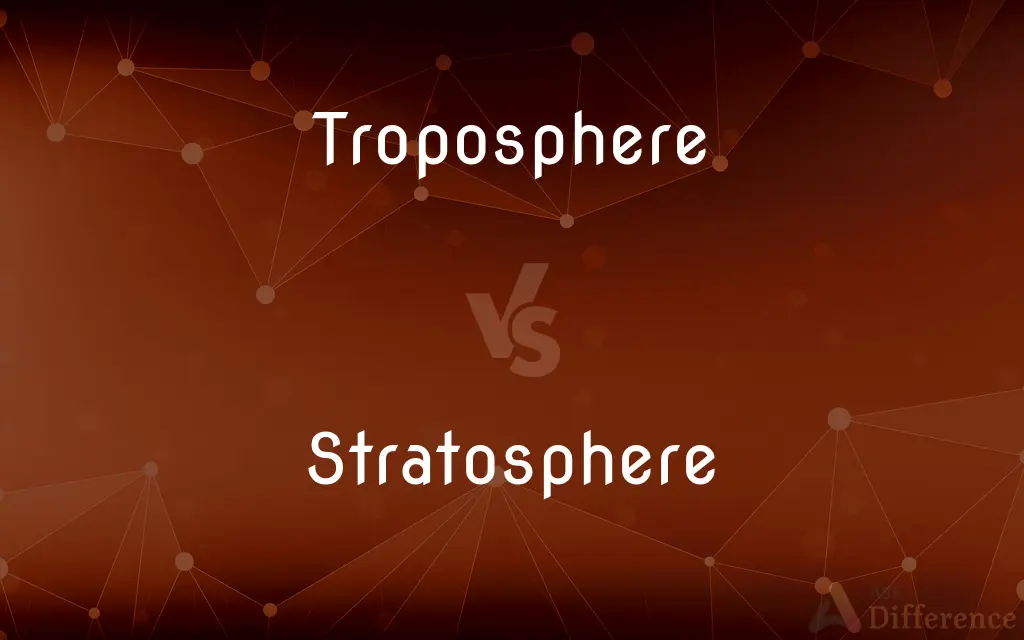Troposphere vs. Stratosphere — What's the Difference?
Edited by Tayyaba Rehman — By Fiza Rafique — Updated on September 29, 2023
The Troposphere is the Earth's lowest atmospheric layer, where weather occurs, while the Stratosphere lies above it, containing the ozone layer.

Difference Between Troposphere and Stratosphere
Table of Contents
ADVERTISEMENT
Key Differences
The Troposphere and Stratosphere are both layers of Earth's atmosphere, with the Troposphere being the closest to Earth's surface and the Stratosphere situated directly above it.
One of the primary characteristics of the Troposphere is that it's where the planet's weather events, like rain and storms, take place. The Stratosphere, on the other hand, is relatively calm and is notable for housing the ozone layer, which absorbs and scatters the sun's ultraviolet solar radiation.
The temperature profile is distinct in both layers. In the Troposphere, the temperature generally decreases with altitude, whereas in the Stratosphere, it increases due to the absorption of UV radiation by the ozone layer.
Jet aircraft prefer to cruise in the lower Stratosphere because of its stability and minimal turbulence, unlike the Troposphere which can be more turbulent.
The Troposphere typically extends to about 8 to 15 kilometers (5 to 9 miles) above the Earth's surface, while the Stratosphere starts right after and stretches up to 50 kilometers (31 miles) high.
ADVERTISEMENT
Comparison Chart
Position
Closest to Earth
Above the Troposphere
Main Feature
Weather phenomena occur here
Contains the ozone layer
Temperature Trend
Decreases with altitude
Increases with altitude due to ozone absorption
Air Traffic
Generally experiences more turbulence
Preferred by jet aircraft for its stability
Altitude Range
Up to 8-15 kilometers (5-9 miles)
15 to 50 kilometers (9-31 miles)
Compare with Definitions
Troposphere
Earth's lowest atmospheric layer.
Weather events predominantly occur in the Troposphere.
Stratosphere
Contains the ozone layer.
The Stratosphere plays a critical role in blocking harmful UV radiation.
Troposphere
Contains approximately 80% of the atmosphere's mass.
The density of air is greatest in the Troposphere.
Stratosphere
Has minimal weather phenomena.
You won't find typical weather events in the Stratosphere.
Troposphere
Where weather phenomena take place.
Storms and rain are formed within the Troposphere.
Stratosphere
Layer of the atmosphere above the Troposphere.
The Stratosphere is recognized for its calm nature.
Troposphere
Temperature decreases with altitude.
As we climb higher in the Troposphere, it gets colder.
Stratosphere
Preferred by jet aircraft for cruising.
Jets fly in the Stratosphere to avoid turbulence below.
Troposphere
Generally more turbulent than the Stratosphere.
Pilots often face turbulence in the Troposphere.
Stratosphere
Temperature rises with increasing altitude.
The warmth in the Stratosphere increases as you ascend.
Troposphere
The troposphere is the first layer of the atmosphere of the Earth, and contains 75% of the mass of the planetary atmosphere and 99% of the total mass of water vapour and aerosols, and is where most weather phenomena occur. The average height of the troposphere is 18 km (11 mi; 59,000 ft) in the tropics, 17 km (11 mi; 56,000 ft) in the middle latitudes, and 6 km (3.7 mi; 20,000 ft) in the polar regions in winter; thus, the total average height of the troposphere is 13 km (8.1 mi; 43,000 ft).
Stratosphere
The stratosphere () is the second major layer of Earth's atmosphere, just above the troposphere, and below the mesosphere. The stratosphere is stratified (layered) in temperature, with warmer layers higher and cooler layers closer to the Earth; this increase of temperature with altitude is a result of the absorption of the Sun's ultraviolet (UV) radiation by the ozone layer.
Troposphere
The lowest region of the atmosphere between the earth's surface and the tropopause, characterized by decreasing temperature with increasing altitude.
Stratosphere
The region of the atmosphere above the troposphere and below the mesosphere.
Troposphere
The lower levels of the atmosphere extending from the surface of the Earth or another celestial body up to the tropopause. It is characterized by convective air movements and a large vertical temperature change.
Stratosphere
An extremely high or the highest point or degree on a ranked scale
Business expenses in the stratosphere.
Troposphere
The lowest atmospheric layer; from 4 to 11 miles high (depending on latitude)
Stratosphere
Collectively, those layers of the Earth’s crust which primarily comprise stratified deposits.
Stratosphere
(meteorology) The region of the uppermost atmosphere where temperature increases along with the altitude due to the absorption of solar ultraviolet radiation by ozone. The stratosphere extends from the tropopause (10–15 kilometers) to approximately 50 kilometers, where it is succeeded by the mesosphere.
Stratosphere
The atmospheric layer between the troposphere and the mesosphere
Common Curiosities
Which atmospheric layer is directly above the Troposphere?
The Stratosphere is directly above the Troposphere.
Where is the ozone layer located?
The ozone layer is located in the Stratosphere.
Is the temperature profile the same in the Troposphere and Stratosphere?
No, temperature decreases with altitude in the Troposphere and increases in the Stratosphere.
Are there clouds in the Stratosphere?
Generally, clouds are rare in the Stratosphere, with exceptions like nacreous clouds.
Why do jet aircraft prefer to fly in the Stratosphere?
Jets prefer the Stratosphere due to its stability and minimal turbulence.
In which layer does most of Earth's weather occur?
Most weather events occur in the Troposphere.
Is the Stratosphere closer to space?
Yes, the Stratosphere is closer to space than the Troposphere.
How high does the Troposphere extend?
The Troposphere extends up to about 8-15 kilometers (5-9 miles) above the Earth.
Which layer contains the majority of the atmosphere's mass?
The Troposphere contains about 80% of the atmosphere's mass.
Share Your Discovery

Previous Comparison
Blessing vs. Mercy
Next Comparison
Atoll vs. IslandAuthor Spotlight
Written by
Fiza RafiqueFiza Rafique is a skilled content writer at AskDifference.com, where she meticulously refines and enhances written pieces. Drawing from her vast editorial expertise, Fiza ensures clarity, accuracy, and precision in every article. Passionate about language, she continually seeks to elevate the quality of content for readers worldwide.
Edited by
Tayyaba RehmanTayyaba Rehman is a distinguished writer, currently serving as a primary contributor to askdifference.com. As a researcher in semantics and etymology, Tayyaba's passion for the complexity of languages and their distinctions has found a perfect home on the platform. Tayyaba delves into the intricacies of language, distinguishing between commonly confused words and phrases, thereby providing clarity for readers worldwide.
















































